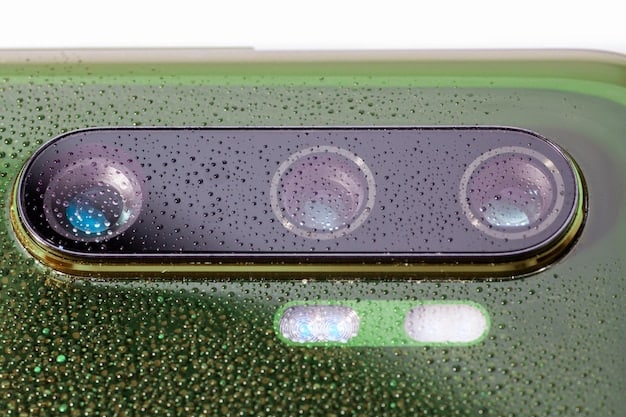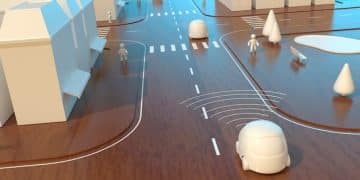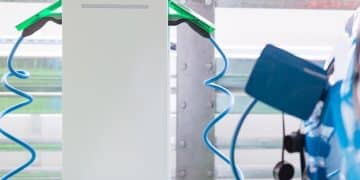LiDAR vs. Radar: The Future of Self-Driving Cars by 2026

LiDAR (Light Detection and Ranging) and radar are both crucial sensor technologies for self-driving cars, but the question of which will dominate by 2026 depends on ongoing developments in cost, performance, and regulatory standards in the automotive industry.
The race is on to perfect self-driving car technology, and at the heart of it lies a crucial decision: **LiDAR vs. Radar: Which Sensor Technology Will Dominate Self-Driving Cars by 2026?** Understanding the strengths and weaknesses of each is key to predicting the future of autonomous vehicles.
Understanding LiDAR Technology
LiDAR (Light Detection and Ranging) has become a prominent technology in the development of self-driving cars. It uses laser light to create a detailed 3D map of the surroundings. But how exactly does it work, and what are its key advantages?
How LiDAR Works
LiDAR works by emitting rapid pulses of laser light and measuring the time it takes for the light to return after hitting an object. These measurements are then used to calculate the distance to the object.
The data is used to generate point clouds. A point cloud is a set of data points in space. The 3D model is created with those data to provide an accurate understanding of the environment.
Advantages of LiDAR
LiDAR offers several key advantages over other sensor technologies, particularly regarding accuracy and resolution. Its high-resolution 3D maps enable precise object detection and tracking.
- High-Resolution Imaging: LiDAR provides extremely detailed and accurate 3D imaging, allowing for better object recognition.
- Object Detection: It excels at detecting and classifying objects, making it easier for self-driving systems to understand the road conditions.
- Range Accuracy: LiDAR is known for its accuracy in measuring distances, which is essential for safe navigation.
Despite its numerous benefits, LiDAR technology also presents some challenges. The cost of LiDAR systems is still relatively high, which can limit its adoption in mass-market vehicles. In terms of weather conditions, LiDAR performance can be affected by heavy rain and snow.
The Role of Radar in Autonomous Driving
Radar (Radio Detection and Ranging) is another important technology used in self-driving cars. Radar uses radio waves to detect objects and measure their distance and speed. It has been a long-established technology for automotive safety.
How Radar Functions
Radar works by emitting radio waves that bounce off objects. By measuring the time it takes for the radio waves to return, radar can determine the distance and speed of the object.
Radar systems are often used to complement other sensor technologies, such as cameras and LiDAR. This redundancy helps to ensure safety and reliability in various driving conditions.
Key Benefits of Radar
Radar is well known for its robustness and ability to function effectively in various weather conditions. It can penetrate rain, fog, and snow, making it a reliable choice for all-weather autonomous driving.
- All-Weather Performance: Radar can operate effectively in adverse weather conditions, such as rain, fog, and snow.
- Long-Range Detection: It is capable of detecting objects at long distances, providing ample time for the vehicle to react.
- Cost-Effectiveness: Radar systems are generally more affordable compared to LiDAR systems, making them a practical choice for wider deployment.
However, radar does have limitations. It typically offers lower resolution compared to LiDAR, which can make it difficult to accurately identify objects. Radar can also be susceptible to interference from other electronic devices.

Comparing LiDAR and Radar: Strengths and Weaknesses
LiDAR and radar technologies each have their unique strengths and weaknesses. Understanding these differences is essential for determining which technology, or combination thereof, will prevail in the future of self-driving cars.
Accuracy and Resolution
LiDAR generally offers higher accuracy and resolution compared to radar. LiDAR creates detailed 3D maps, enabling precise object detection and classification.
Radar provides lower resolution, which can sometimes make it difficult to distinguish between different types of objects. It excels in providing range information but lacks the detailed imaging capabilities of LiDAR.
Weather Performance
Radar has superior all-weather performance compared to LiDAR. Radar signals can penetrate rain, fog, and snow with greater ease.
LiDAR performance can be degraded by adverse weather conditions, such as heavy rain or snow, which can scatter the laser light and reduce the effective range.
Cost Considerations
Radar systems are generally more cost-effective than LiDAR systems. The lower cost of radar makes it a more accessible option for mass-market vehicles.
LiDAR systems, while becoming more affordable, still carry a higher price tag. Cost is the main factor limiting its widespread adoption until prices decrease further.
In summary, LiDAR excels in accuracy and resolution but has weather limitations and higher costs. Radar offers robustness in all weather conditions and is more affordable but has lower resolution. The ideal solution may involve a combination of both.
Innovations and Future Trends in Sensor Technology
The field of sensor technology is rapidly evolving, with numerous innovations aimed at improving the performance and reducing the cost of both LiDAR and radar systems. These advancements are critical for the future of autonomous driving.
Solid-State LiDAR
Solid-state LiDAR technology is a new approach that eliminates many of the moving parts found in traditional LiDAR systems. This can reduce costs and improve reliability.
Solid-state LiDAR systems are designed to be more compact, energy-efficient, and durable. It increases its appeal for automotive applications.
4D Imaging Radar
4D imaging radar is an advanced radar technology that provides higher resolution and more detailed information about the environment. This technology adds the elevation component.
4D imaging radar can enhance object detection and classification capabilities, bringing the performance of radar closer to that of LiDAR. It represents a significant step forward in radar technology.
Sensor Fusion
Sensor fusion involves combining data from multiple sensors, such as LiDAR, radar, and cameras, to create a more complete and accurate understanding of the vehicle’s surroundings.
Sensor fusion enables the strengths of each sensor to compensate for the weaknesses of others. This holistic approach enhances the overall reliability and safety of self-driving systems.
These innovations are pushing the boundaries of what is possible with sensor technology, paving the way for more advanced and reliable self-driving cars.
Predictions: LiDAR vs. Radar by 2026
Predicting which sensor technology will dominate the self-driving car market by 2026 depends on several factors, including technological advancements, cost reductions, and regulatory developments. There are varied opinions.
Scenario 1: LiDAR Dominance
One scenario is that LiDAR technology continues to improve rapidly, with significant cost reductions making it more accessible. Also, weather performance could be enhanced through advanced signal processing techniques.
In this scenario, LiDAR, with its superior accuracy and resolution, could become the standard sensor technology for high-level autonomous vehicles. Vehicles designed for full autonomy would depend on it.
Scenario 2: Radar Prevails
Another scenario is that radar technology continues to advance, particularly with the development of 4D imaging radar. The advancements address its limitations.
In this scenario, radar’s robustness, all-weather performance, and cost-effectiveness could make it the preferred choice for most self-driving cars. The more affordable option would make it more viable for commercial use.
Scenario 3: Hybrid Approach
A third scenario involves a hybrid approach. This approach may combine LiDAR and radar. The system is complemented by cameras and other sensors to achieve optimal performance.
This hybrid approach is increasingly seen as the most likely outcome, as it allows for the strengths of each technology to be leveraged. Sensor fusion becomes essential to maximize safety and reliability, allowing the vehicle to adapt to different driving conditions.
The future of self-driving car sensor technology may depend on a blend of LiDAR, radar, and other sensors, but a hybrid approach is one of the most promising options.
Regulatory and Standardization Impacts
Regulatory standards and industry-wide standardization efforts will play a significant role in the adoption of LiDAR and radar technologies in self-driving cars. These standards will ensure safety and reliability.
Safety Standards
Regulatory bodies are likely to establish safety standards for self-driving car sensor systems, including requirements for accuracy, reliability, and redundancy. These standards could favor technologies that offer the highest levels of safety assurance.
Safety standards may drive the adoption of sensor fusion approaches, combining LiDAR, radar, and cameras to provide multiple layers of safety.
Performance Benchmarks
Performance benchmarks could be established to evaluate the effectiveness of different sensor technologies in various driving conditions. These benchmarks could help to guide automakers in their technology choices.
- Object Detection: Benchmarks for accurately detecting and classifying objects.
- Weather Performance: Criteria for maintaining performance in adverse weather.
- Range Accuracy: Standards for precise distance measurement and spatial awareness.
Industry Collaboration
Collaboration among automakers, technology companies, and regulatory agencies is essential for developing and implementing effective standards. Shared efforts and technological innovation will aid progress.
Collaborative efforts can help to accelerate the development and deployment of self-driving car technology. Standardization helps assure compliance across different technology developers.
| Key Aspect | Brief Description |
|---|---|
| 💡 LiDAR | High accuracy and resolution, but can be affected by weather and has a higher cost. |
| 📡 Radar | Functions well in all weather conditions and is more cost-effective, but offers lower resolution. |
| 🤝 Sensor Fusion | Combines data from multiple sensors to create a complete and accurate understanding of the environment. |
| ⚖️ Regulation | Safety standards and performance benchmarks will significantly impact LiDAR and radar adoption. |
FAQ
▼
LiDAR (Light Detection and Ranging) employs laser light pulses to generate a detailed 3D map. Measuring the return time of light, it accurately calculates distances, aiding in precise object detection for self-driving systems.
▼
Radar excels in all-weather performance, functioning effectively in rain, fog, and snow. It offers long-range detection and cost-effectiveness, making it a reliable choice for autonomous driving in adverse conditions.
▼
Solid-state LiDAR eliminates moving parts, enhancing durability and reducing costs. These systems are more compact and energy-efficient, making them suitable for automotive applications and mass production.
▼
Sensor fusion combines data from multiple sensors, such as LiDAR, radar, and cameras, to provide a robust view of the vehicle’s surroundings. It maximizes safety by compensating for individual sensor weaknesses.
▼
Regulatory bodies establishing safety and performance standards for sensor systems will significantly influence technology choices. Stricter safety requirements may favor hybrid approaches, ensuring multiple layers of redundancy in autonomous vehicles.
Conclusion
In summary, both LiDAR and radar offer unique strengths for self-driving cars, with the dominant technology by 2026 likely determined by advancements in cost, performance, and regulatory standards. A hybrid approach, integrating both LiDAR and radar with other sensors, currently seems the most promising path toward achieving safe and reliable autonomous driving.





